Kedah is a state in Malaysia that is home to various birds. The lush green environment, with its mangroves, wetlands, and forests, provides a perfect habitat for numerous birds.
The variety of birds in Kedah ranges from common backyard birds like sparrows and doves to rare and endangered species like the critically endangered white-crowned shama.
The birdlife in Kedah is also enriched by migrants from neighboring countries who make their way to Kedah during the winter months. With its abundance of birds, Kedah is an excellent location for bird watching and nature photography.
24 Birds to Watch in Kedah
Kedah is a state in northern Malaysia that offers a variety of habitats for birdwatching enthusiasts. Whether looking for forest, wetland, or coastal birds, you will find something to suit your interest in Kedah.
Here are 24 birds that you should not miss when visiting this state.
1. Spotted Dove
The spotted dove (Spilopelia chinensis) is a small, long-tailed bird native to the Indian subcontinent and Southeast Asia. It is a common breeding bird in these regions and has even been introduced to many other parts of the world.
In some areas, the spotted dove has become established in the wild, creating feral populations. The spotted dove is approximately 28 cm long and is generally light brown with black spots on its wings.
Its tail is long and pointed, and its legs and feet are pinkish-red.
The spotted dove is typically found in open woodland, scrub, and cultivation and feeds on seeds, grains, and other plant material. The spotted dove is monogamous, and pairs build a simple nest from twigs and sticks.
The female typically lays two white eggs, which are incubated for 14 days before hatching.
The chicks are altricial and require parental care for several weeks before they can fly. The spotted dove is a common sight across its native range, and its ability to adapt to new environments has enabled it to spread to many other parts of the world.
Although its population is not threatened, it is essential to monitor introduced populations as they could potentially cause harm to native species.
| Kingdom | Animalia |
| Phylum | Chordata |
| Class | Aves |
| Order | Columbiformes |
| Family | Columbidae |
| Genus | Spilopelia |
| Species | S. chinensis |
2. Thick-billed Green Pigeon
The thick-billed green pigeon is a beautiful species of bird found in the Columbidae family. It is a large bird with an impressive wingspan reaching up to 39 inches. Its body is primarily green, with a pale yellow underside and a bright yellow beak.
The thick-billed green pigeon is native to India, Sri Lanka, Myanmar, and Thailand and inhabits areas of dense vegetation. It is usually seen perched on the top of trees, looking for fruit and nuts.
The diet of the thick-billed green pigeon consists mainly of fruits, nuts, seeds, buds, and other vegetation. A social species often lives in flocks of up to 20 individuals.
It is a vocal species with various calls to communicate with its flock mates. The thick-billed green pigeon is an essential species for the environment as it helps disperse the seeds of the plants it eats.
It is also an important species for humans as it is hunted for food in some areas.
| Kingdom | Animalia |
| Phylum | Chordata |
| Class | Aves |
| Order | Columbiformes |
| Family | Columbidae |
| Genus | Treron |
| Species | T. curvirostra |
3. Zebra Dove
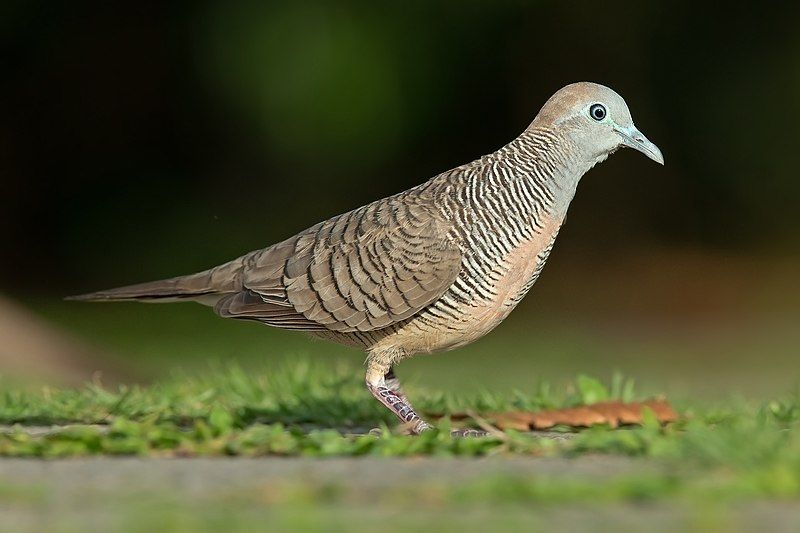
The zebra dove is a species of bird that belongs to the Columbidae family, commonly known as doves. This dove species is native to Southeast Asia and is easily recognizable due to its small size and long tail.
Its plumage is predominantly brownish-grey in color, with black-and-white barring. This pattern of black-and-white barring gives the zebra dove its alternate name, the barred ground dove or barred dove.
The zebra dove is unique in that it prefers to live on the ground rather than in trees, as many other doves do. It is also known for its distinct call, a low-pitched coo. The zebra dove is active during the day and often seen in small flocks, foraging for food.
Its diet consists mainly of seeds, fruits, and insects. The zebra dove is an interesting species that can be easily spotted in its native Southeast Asian habitats.
Its unique color pattern and call make it unmistakable in the wild, and it is a bird that birdwatchers and casual observers alike can enjoy.
| Kingdom | Animalia |
| Phylum | Chordata |
| Class | Aves |
| Order | Columbiformes |
| Family | Columbidae |
| Genus | Geopelia |
| Species | G. striata |
4. Pink-necked Green Pigeon
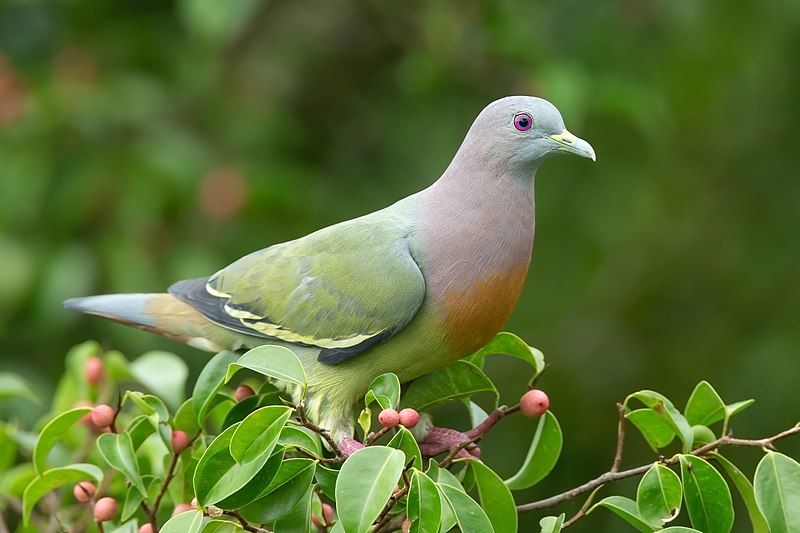
The pink-necked green pigeon is a species of bird belonging to the Columbidae family, the same family as pigeons and doves. It is found in Southeast Asia, from Myanmar and Vietnam and southwards to the major islands of Indonesia and the Philippines.
This species is quite common in these areas, making it easy to identify and observe. The pink-necked green pigeon is a 27-30 cm long medium-sized bird. Its body is mainly green, with a pinkish hue on the neck and head.
It has a short, broad bill and a wide wingspan. This species is usually found in open woodlands, gardens, and parks. The pink-necked green pigeon feeds mainly on buds, shoots, fruits, and seeds. It also sometimes eats insects.
This species is very social and often congregates in large flocks, roosting and foraging together.
During nesting season, pairs of pink-necked green pigeons may build their nests in tree hollows or on tree branches. The pink-necked green pigeon is an essential species in Southeast Asia, providing a vital food source for humans and other animals.
It is also an essential part of the ecosystem, as its droppings help fertilize the soil and provide plant nutrients. The pink-necked green pigeon is a bird species worth protecting and conserving.
| Kingdom | Animalia |
| Phylum | Chordata |
| Class | Aves |
| Order | Columbiformes |
| Family | Columbidae |
| Genus | Treron |
| Species | T. vernans |
5. Emerald Dove
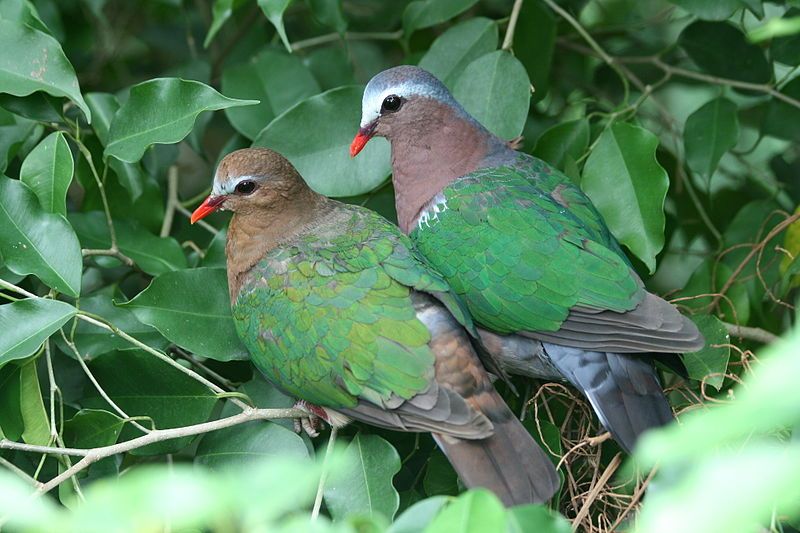
The Emerald Dove, also known as the Common Emerald Dove, Asian Emerald Dove, Grey-Capped Emerald Dove, Green Dove, and Green-Winged Pigeon, is a widespread resident breeding pigeon native to the tropical and subtropical parts of the Indian Subcontinent and Southeast Asia.
This bird is highly esteemed and is an essential species in Indian culture. The Emerald Dove is a medium-sized species of pigeon with a length of 25 to 30 centimeters and a wingspan of up to 40 centimeters.
It is predominantly green, with a grey cap on its head and a white streak on its wings.
Its tail has a white tip, and its legs and feet are red. The Emerald Dove is a highly adaptable species, living in various habitats, including grasslands, woodlands, gardens, and urban areas. It is an omnivorous species, feeding on seeds, fruits, and insects.
The Emerald Dove is typically found in small flocks, often in the company of other species of pigeons and doves. It has a fast, direct flight and is a good flier. The Emerald Dove is monogamous and typically breeds during the wet season.
The female lays two white eggs in a shallow nest on the ground or in a bush or tree. The female incubates the eggs for 13 to 15 days before hatching.
Both parents take part in raising the young. The Emerald Dove is an essential species in Indian culture, often seen as a symbol of love and fidelity. It is also a vital food source for many native people in the region.
The species is not currently threatened, but its population is declining due to habitat loss and hunting. Conservation efforts are underway to ensure the survival of this species.
| Kingdom | Animalia |
| Phylum | Chordata |
| Class | Aves |
| Order | Columbiformes |
| Family | Columbidae |
| Genus | Chalcophaps |
| Species | C. indica |
6. Chestnut-breasted Malkoha
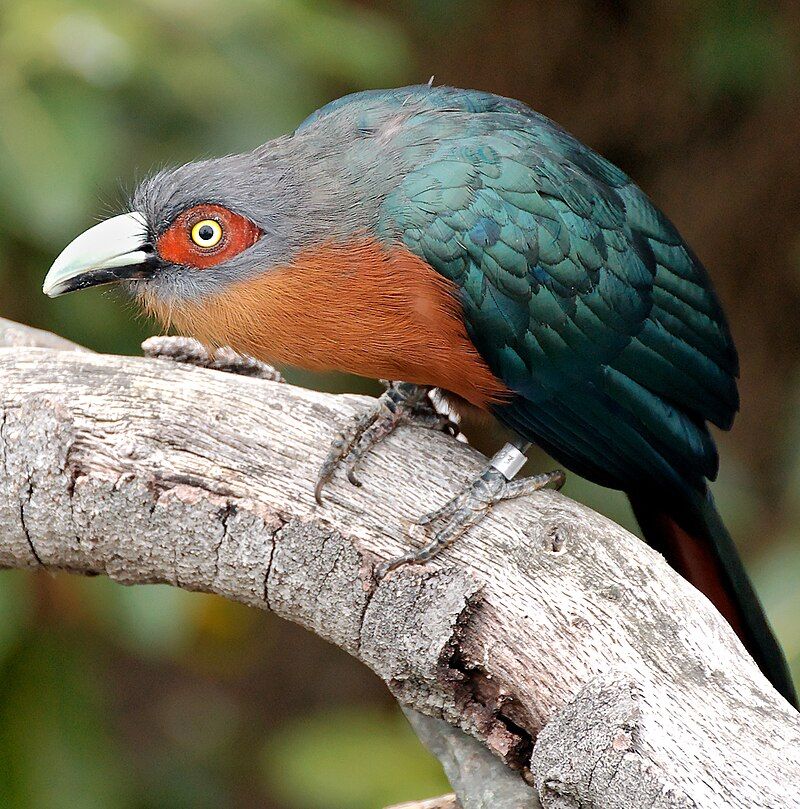
The chestnut-breasted malkoha is a species of cuckoo found in Southeast Asia. Its native range extends from Myanmar to eastern Java, the Philippines, and Borneo. It is a relatively large cuckoo, measuring up to 49 cm long.
Its coloring combines grey and dark green on its upperparts and chestnut on its underparts. The chestnut-breasted malkoha is also notable for its large, curved upper mandible, which is usually pale.
These birds are shy and often difficult to spot in the wild, as they prefer to stay hidden in dense foliage. They feed mainly on insects, with some berries and fruit also being part of their diet.
They breed during the dry season, and their nests, constructed from twigs and leaves, can be found in bushes or trees. The chestnut-breasted malkoha is listed as a species of most minor concern by the International Union for Conservation of Nature.
Despite this, their population is still in decline due to loss of habitat, hunting, and trapping for the pet trade. Conservation efforts are needed to ensure the continued survival of this species.
| Kingdom | Animalia |
| Phylum | Chordata |
| Class | Aves |
| Order | Cuculiformes |
| Family | Cuculidae |
| Genus | Phaenicophaeus |
| Species | P. curvirostris |
7. Banded Bay Cuckoo
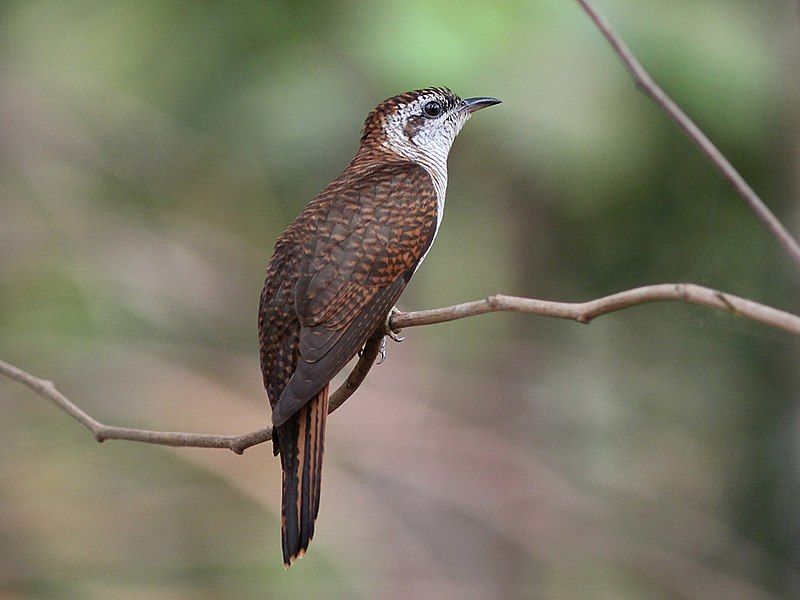
The banded bay cuckoo, also known as the bay-banded cuckoo, is a small cuckoo found in the Indian subcontinent and Southeast Asia. It belongs to the genus of cuckoos known for their round nostrils.
This cuckoo species prefers to inhabit well-wooded areas, notably lower hills. They are not found in open areas or grasslands. The cuckoos are known to feed on insects, small reptiles, and fruit.
These cuckoos are also known to be quite vocal, with a variety of calls ranging from loud cackling to soft cooing. They also migrate between different regions to find the best food sources.
The banded bay cuckoo is an essential species in the local ecology and is an integral part of the food chain.
| Kingdom | Animalia |
| Phylum | Chordata |
| Class | Aves |
| Order | Cuculiformes |
| Family | Cuculidae |
| Genus | Cacomantis |
| Species | C. sonneratii |
8. Red Junglefowl
The red junglefowl (Gallus gallus) is a species of bird in the family Phasianidae, which includes other poultry species such as pheasants and peafowl. It is found across much of Southeast and parts of South Asia and is often seen in the wild in these regions.
It is also known as the bankiva or bankiva fowl, dating back to its earliest known classification by the Dutch scientist Coenraad Temminck in 1820.
It is the wild ancestor of the domestic chicken and has been widely domesticated for centuries. The red junglefowl is a large bird, with the males standing about 80 centimeters tall and weighing up to 2.2 kilograms.
The feathers on its head and neck are bright red, while the body is covered in black and white feathers. The wings and tail are also brightly colored, with green and blue feathers.
The red junglefowl is an omnivore, eating various seeds, fruits, insects, and other small animals.
It is an adaptable species and can survive in a wide range of habitats, from dense forests to open grasslands. The red junglefowl is an essential cultural symbol in its range.
It is the national bird in India, depicted in many Hindu religious texts and sculptures. In Southeast Asia, it is seen as a symbol of strength and fertility and is sometimes used in traditional medicine.
The red junglefowl is also an essential food source for humans, with its meat being widely consumed. It is also hunted for its feathers, used in traditional crafts.
Despite its cultural and economic importance, the red junglefowl is threatened by habitat loss and hunting pressure, and its population is declining.
| Kingdom | Animalia |
| Phylum | Chordata |
| Class | Aves |
| Order | Galliformes |
| Family | Phasianidae |
| Genus | Gallus |
| Species | G. gallus |
9. Drongo Cuckoo
The square-tailed drongo-cuckoo is a species of cuckoo that is highly similar in appearance to a black drongo. It is part of the S. lugubris species, which historically included the subspecies Dicruroides.
However, this subspecies is now recognized as a separate species, known as the fork-tailed drongo-cuckoo. The two species share many physical characteristics, including a black-colored body, a long tail, and a sharp, hooked beak.
They also display similar behavior, such as an affinity for perching on exposed branches and a tendency to hunt insects in the air. However, the square-tailed drongo-cuckoo is slightly larger than its relative and has a shorter, more square-shaped tail.
| Kingdom | Animalia |
| Phylum | Chordata |
| Class | Aves |
| Order | Cuculiformes |
| Family | Cuculidae |
| Genus | Surniculus |
| Species | S. lugubris |
10. Large-tailed Nightjar
The large-tailed nightjar is a species of nightjar, a type of bird in the family Caprimulgidae. It is a pretty widespread species found in various habitats across a large area.
Its range extends from the southern Himalayan foothills in the west across eastern South Asia, Southeast Asia, and northern Australia in the east.
Its preferred habitats are open areas such as savanna, grassland, and scrub, as well as more wooded areas such as woodland and mangroves. It is primarily a nocturnal species and has adapted to feed on insects in the dark.
Its plumage is primarily greyish-brown, with lighter colors on its throat and underside and a distinctive white patch on its tail. It is a relatively small bird with a wingspan of around 20-25cm and a roughly 16-17cm length.
| Kingdom | Animalia |
| Phylum | Chordata |
| Class | Aves |
| Clade | Strisores |
| Order | Caprimulgiformes |
| Family | Caprimulgidae |
| Genus | Caprimulgus |
| Species | C. macrurus |
11. Green Imperial Pigeon
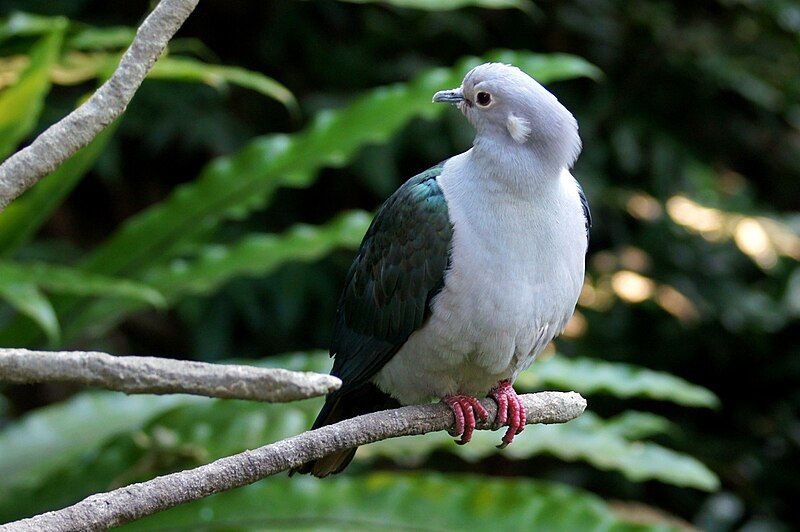
The green imperial pigeon is a large and majestic bird found in a wide range of habitats. Its range stretches from Nepal in the west to southern India and Sri Lanka further south and eastwards to southern China, Indonesia, and the Philippines.
It is an integral part of the forest ecosystem in these countries, as it is an important seed disperser and food source for many other species. The green imperial pigeon is highly sought after as a game bird due to its size and attractive plumage.
It is usually found in forested areas but can also be seen in open woodlands and around human settlements.
Its diet consists mainly of fruits and berries but has also been known to eat small insects and worms. The green imperial pigeon is quite a large bird, with a length of up to 40 cm and a wingspan of up to 70 cm.
Its plumage is a beautiful combination of green and purple, with a white patch at the back of its neck.
Males are generally more colorful than females. In recent years, the population of the green imperial pigeon has been declining due to habitat destruction, hunting, and the pet trade. Conservation efforts are needed to ensure this beautiful bird is not lost forever.
| Kingdom | Animalia |
| Phylum | Chordata |
| Class | Aves |
| Order | Columbiformes |
| Family | Columbidae |
| Genus | Ducula |
| Species | D. aenea |
12. Pied Imperial Pigeon
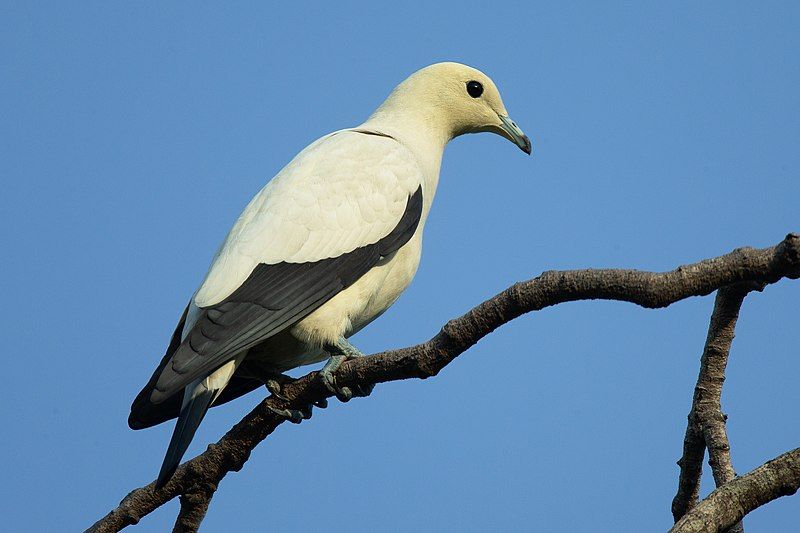
The pied imperial pigeon is a species of pigeon that is relatively large and has a unique two-tone coloring with white and black feathers. It is found in a wide variety of habitats, including forests, woodlands, mangroves, plantations, and scrub, throughout Southeast Asia.
The range of this species extends from Myanmar and Thailand through Indonesia and to the Philippines and the Bird’s Head Peninsula in New Guinea. The pied imperial pigeon has been known to feed on fruit, seeds, and other vegetation in these areas.
It is also an important food source for some local populations and is kept in captivity. The pied imperial pigeon is a largely passive species but may undertake short migrations in some areas.
It is not considered threatened, although its population has decreased in certain areas due to habitat destruction and hunting.
| Kingdom | Animalia |
| Phylum | Chordata |
| Class | Aves |
| Order | Columbiformes |
| Family | Columbidae |
| Genus | Ducula |
| Species | D. bicolor |
13. Blue-breasted Quail
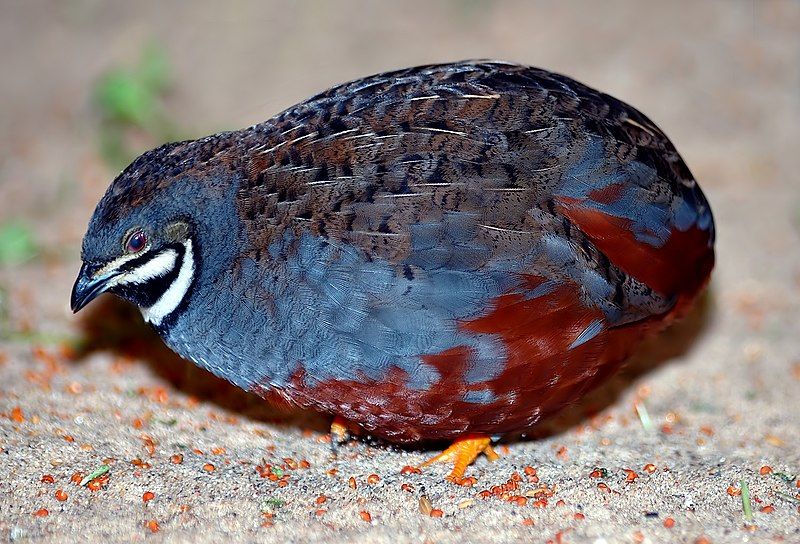
The King Quail, also known as the Blue-Breasted Quail, Asian Blue Quail, Chinese Painted Quail, or Chung-Chi, is a species of bird from the family Phasianidae.
It is a small quail that is native to East and Southeast Asia and is often kept as an ornamental bird in aviaries due to its beautiful coloration.
It is a ground-dwelling species found in grasslands, open fields, and scrubby areas. The King Quail is small, measuring 16-19 cm (6-7.5 inches) in length. It has a brown back and wings, and its head and chest are blue.
The bird has a black mask around its eyes, and its underside is white, with a brown stripe running down its back. Its tail is long and pointed. The King Quail is a diurnal species that is active during the day.
It is a gregarious bird usually found in groups of up to 20 individuals. It prefers to feed on seeds, fruits, and insects.
It is a vocal species and produces a variety of chirps, whistles, and other noises. The King Quail is a famous bird in aviculture due to its attractive coloration and hardiness. It can be bred in captivity and is also kept as a pet.
It is not considered threatened and is listed as a species of Least Concern on the IUCN Red List.
| Kingdom | Animalia |
| Phylum | Chordata |
| Class | Aves |
| Order | Galliformes |
| Family | Phasianidae |
| Genus | Synoicus |
| Species | S. chinensis |
14. Pacific Swift
The Pacific Swift is a species of bird belonging to the Swift family. It is native to eastern Asia and migrates to other parts of the world during the northern hemisphere’s winter. This species of bird is particularly well-known for its migratory solid habits.
They can be found in Southeast Asia and Australia during the winter season. The Pacific swift is most easily recognizable by its distinctive forked tail. This feature is one of the reasons why it is often referred to as the ‘fork-tailed swift.’
Its body is small and slender, and its wings are long and pointed. It has a black back, head, white throat, and underside. It has a total wingspan of around 11 inches.
The Pacific swift is typically found in large flocks, and often, they can be seen flying high in the sky. They are incredibly agile and are capable of reaching high speeds during flight.
They feed mainly on aerial insects, such as flies and moths, which they catch mid-air. The Pacific swift is a fascinating bird species and plays a vital role in the ecosystem.
Its strong migratory habits and ability to survive in various environments make it an integral part of the global avian community.
| Kingdom | Animalia |
| Phylum | Chordata |
| Class | Aves |
| Clade | Strisores |
| Order | Apodiformes |
| Family | Apodidae |
| Genus | Apus |
| Species | A. pacificus |
15. Glossy Swiftlet
The glossy swiftlet is a species of small bird in the family Apodidae, which includes the typical swifts.
It is found in Southeast Asia, most notably on the Indonesian island of Sulawesi, extending eastwards to New Guinea, the Bismarck Archipelago, and the Solomon Islands. This species is small, typically between nine and eleven centimeters in length.
It has a glossy, dark brown plumage and whitish-gray wings. Its diet consists mainly of small flying insects, which it catches on the wing. The glossy swiftlet is a species of bird that is particularly common in its range, and its population is not threatened.
It is an essential species for local cultures, with the birds often being kept in captivity and used for their feathers, which are used for decorations and ritual purposes.
The glossy swiftlet is known to nest in caves and old buildings, although large colonies can sometimes be found in coastal mangrove forests and other natural habitats. The birds are considered monogamous, and the female lays two eggs in a shallow cup-shaped nest.
The young fledge after around three weeks. The glossy swiftlet is an exciting bird species with a stable range and population. It has an important cultural significance to people in its range and is a species that is worth protecting and preserving.
| Kingdom | Animalia |
| Phylum | Chordata |
| Class | Aves |
| Clade | Strisores |
| Order | Apodiformes |
| Family | Apodidae |
| Genus | Collocalia |
| Species | C. esculenta |
16. White-breasted Waterhen
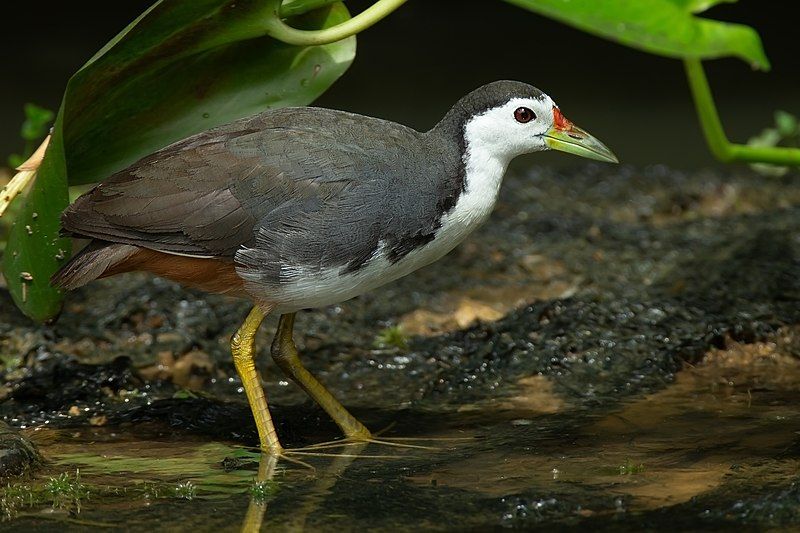
The white-breasted waterhen is a species of waterbird that belongs to the Rallidae family, a family of birds that includes rails and crakes. It is native to many territories, from South Asia to Southeast Asia.
These birds are generally dark in color, with a slaty hue. They are characterized by a white face, breast, and belly, which is a very distinctive feature. Their natural habitat is near freshwater wetlands, such as marshes, ponds, and lakes.
They feed on aquatic insects, small crustaceans, and mollusks. These birds are also known for their loud calls, which can be heard during the day and at night. White-breasted waterhens are social birds, often seen in pairs or small groups.
They have various vocalizations that they use to communicate with each other. They also use their voices to establish their territory. White-breasted waterhens are relatively common in many parts of their range and are not considered to be threatened.
Although they have been known to be hunted for food in some areas, their population appears to be stable overall.
| Kingdom | Animalia |
| Phylum | Chordata |
| Class | Aves |
| Order | Gruiformes |
| Family | Rallidae |
| Genus | Amaurornis |
| Species | A. phoenicurus |
17. Lesser Whistling Duck
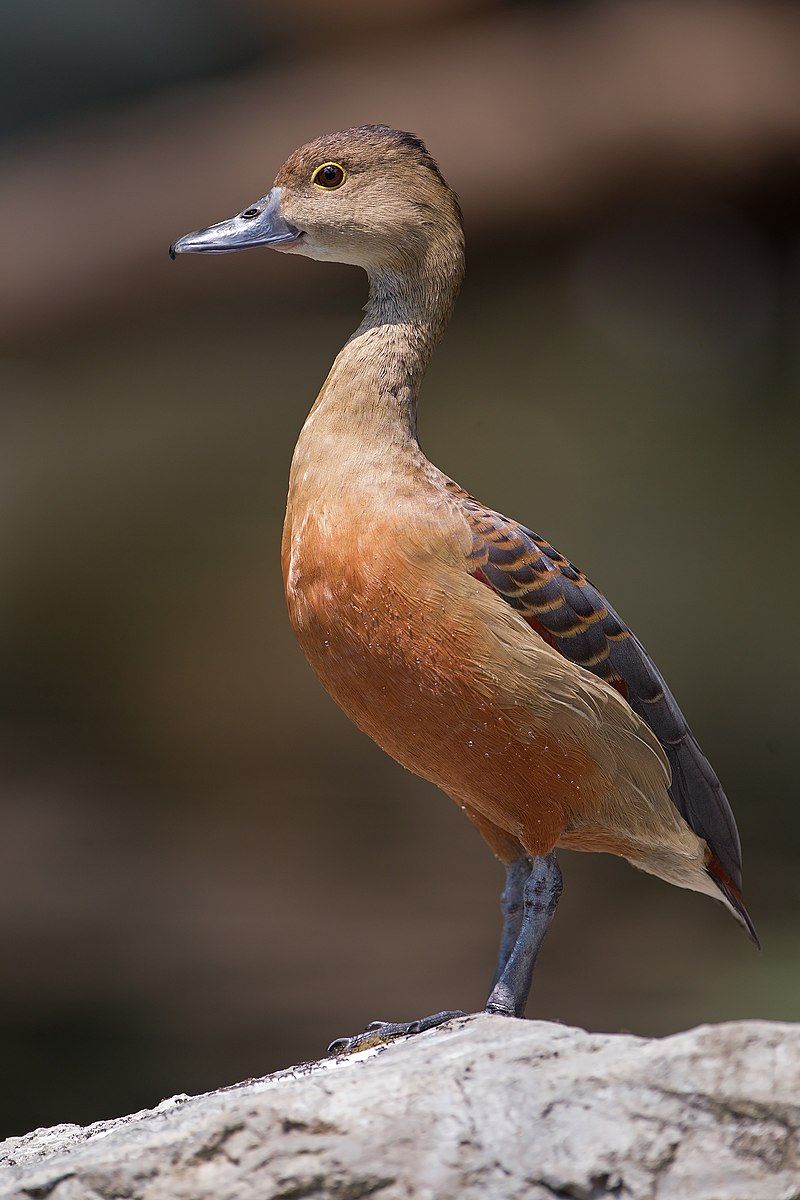
The lesser whistling duck is a species of whistling duck found in the Indian subcontinent and Southeast Asia. It is also known as Indian whistling duck or lesser whistling teal.
These ducks are mainly nocturnal feeders, meaning they come out at night to hunt and forage. During the day, they can often be seen in large flocks around lakes and wet paddy fields.
They make their presence known with their distinctive whistling call, which is why they are called “whistling ducks.” The lesser whistling duck is a relatively small species of duck, measuring about 16 inches long and weighing up to 1.5 pounds.
Its plumage is mainly brown, with a white breast and bright-colored rump. The bill is black, and the legs are dark gray. Females are generally less brightly colored than males.
The lesser whistling duck is an excellent swimmer and can often be spotted swimming in large groups in shallow water. They feed on various aquatic insects, crustaceans, mollusks, and small fish.
The lesser whistling duck is a social species and can often be seen interacting in large flocks.
| Kingdom | Animalia |
| Phylum | Chordata |
| Class | Aves |
| Order | Anseriformes |
| Family | Anatidae |
| Genus | Dendrocygna |
| Species | D. javanica |
18. Chestnut-winged Cuckoo
The chestnut-winged cuckoo is a species of cuckoo found in the regions of Southeast Asia and South Asia. It is easily recognizable by its striking features, including its dark, glossy upperparts, black head with a long crest, and chestnut-colored wings.
This cuckoo also has a long, glossy black tail with a rufous-colored throat and dusky underside. Additionally, a narrow white nuchal half-collar can be seen on the bird. The chestnut-winged cuckoo is a medium-sized bird, typically measuring 24-27cm long.
Its beak is black and curved, making it an effective tool for foraging in trees for insects and small fruits. Its feet are pale yellowish-brown, and its eyes are dark brown.
The chestnut-winged cuckoo is found in various habitats, including tropical forests, mangroves, and agricultural land. This species is usually found alone or in pairs, perched on a branch or flying low over the trees.
Its call is a loud and distinctive “ko-ko-ko-kowk.” In conclusion, the chestnut-winged cuckoo is a beautiful and unique bird, easily recognizable by its distinct features.
It is found in a variety of habitats throughout Southeast Asia and South Asia and can often be heard calling it’s distinctive “ko-ko-ko-kowk.”
| Kingdom | Animalia |
| Phylum | Chordata |
| Class | Aves |
| Order | Cuculiformes |
| Family | Cuculidae |
| Genus | Clamator |
| Species | C. coromandus |
19. Mountain Imperial Pigeon
The mountain imperial pigeon is a species of bird belonging to the pigeon and dove family. It is native to southeastern Asia, with a wide range of habitats.
It is also known as the maroon-backed imperial pigeon or Hodgson’s imperial pigeon, after the British zoologist Brian Houghton Hodgson, who first described the species in 1837. The mountain imperial pigeon is a large bird with a length of around 43–46 cm and a weight of up to 730 g.
Its plumage is primarily maroon-brown with a paler underside and a greenish-black patch on the neck. Its eyes are yellow, and its bill is grey.
The wings are relatively short, with a wingspan of around 65 cm. The mountain imperial pigeon feeds mainly on fruits and nuts, although it will also eat invertebrates and occasionally small vertebrates such as lizards.
It is a gregarious species, usually found in flocks of up to 30 birds.
Breeding occurs in the spring and summer, with females laying up to two eggs in a nesting platform made of twigs and leaves.
The mountain imperial pigeon is not considered to be threatened, although there is evidence of declines in some parts of its range due to deforestation and hunting.
It is protected in many countries, including India, China, and Nepal.
| Kingdom | Animalia |
| Phylum | Chordata |
| Class | Aves |
| Order | Columbiformes |
| Family | Columbidae |
| Genus | Ducula |
| Species | D. badia |
20. Herons
Herons are a type of bird found all around the world. They belong to the family Ardeidae, and there are 72 recognized species. They are recognizable by their long legs and necks, which make them distinct from other birds. Herons can be found in both freshwater and coastal areas.
Some species, such as the Egrets or Bitterns, are sometimes called herons, even though they are not technically the same. Herons are generally quite large birds and can range in color from white to grey to brown.
They eat mainly fish but can also eat small animals or insects. Herons are often found near lakes, ponds, and marshes, where they use their long legs to wade in shallow water for food. They also use their long necks to help them spot prey from far away.
Herons are generally solitary birds but sometimes gather in large groups, especially in the winter when food is scarce.
| Kingdom | Animalia |
| Phylum | Chordata |
| Class | Aves |
| Order | Pelecaniformes |
| Family | Ardeidae |
21. Whistling Hawk Cuckoo
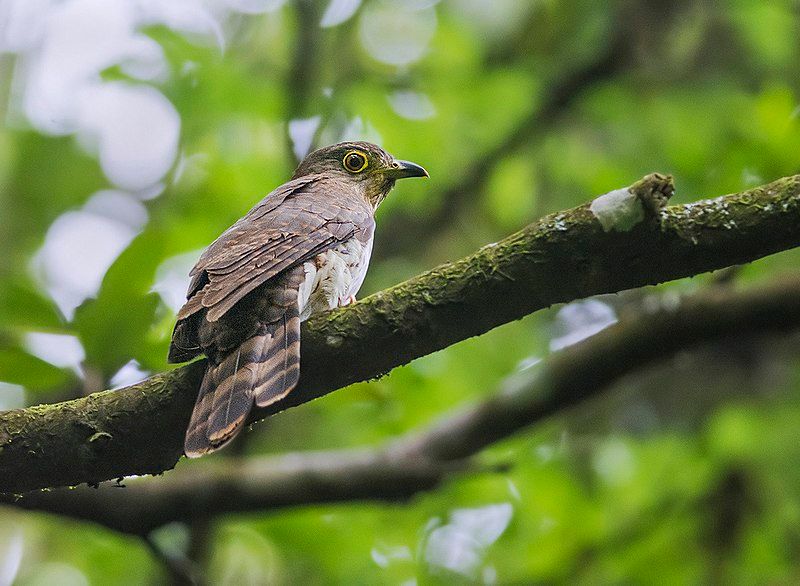
Hodgson’s hawk-cuckoo is a species of cuckoo found in north-eastern India, Myanmar, southern China, and Southeast Asia. It is so-named because it has a distinctive whistling call used to attract its mate.
It is also known as a brood parasite, meaning it lays its eggs in the nests of other birds and leaves them to be raised by the host birds. The young cuckoo then evicts the bona fide residents of the nest, such as eggs and chicks, which makes it the sole occupant.
This behavior allows the cuckoo to take advantage of the resources the host bird has already acquired. It also ensures that the cuckoo chick has a better chance of survival than if it had to find its food and build its own nest.
| Kingdom | Animalia |
| Phylum | Chordata |
| Class | Aves |
| Order | Cuculiformes |
| Family | Cuculidae |
| Genus | Hierococcyx |
| Species | H. nisicolor |
22. Yellow-vented Bulbul
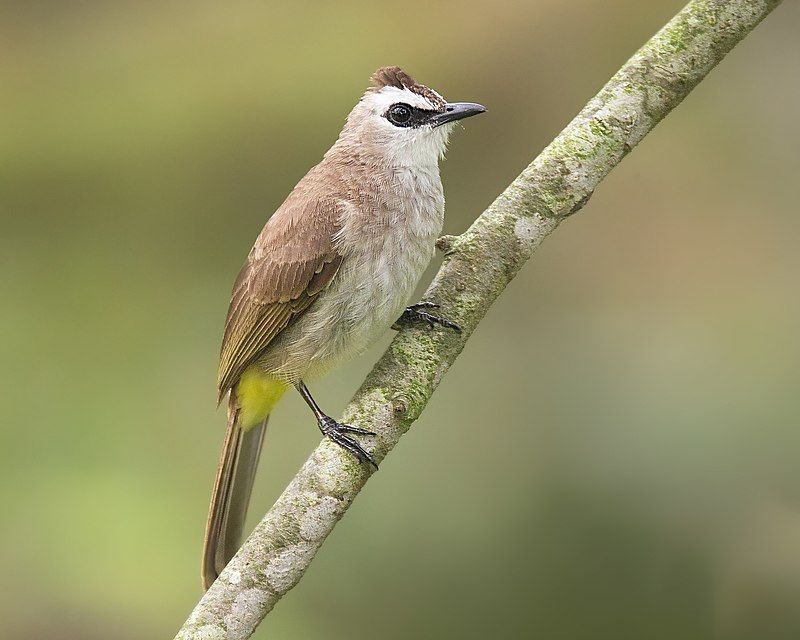
The yellow-vented bulbul is a species of passerine bird belonging to the bulbul family. It is native to Southeast Asia, ranging from Indochina to the Philippines.
This species is usually found in open habitats such as grasslands, scrublands, savannas, and even urban areas, but it avoids dense forests. It is a resident breeder and can be seen throughout the year.
It has a broad diet, mainly consisting of fruits, seeds, small insects, and nectar. It is a social species that often forages in small groups.
The yellow-vented bulbul is a relatively common and unfussy species, but its population has decreased due to habitat destruction and the pet trade. Conservation efforts are needed to protect this species and its habitat.
| Kingdom | Animalia |
| Phylum | Chordata |
| Class | Aves |
| Order | Passeriformes |
| Family | Pycnonotidae |
| Genus | Pycnonotus |
| Species | P. goiavier |
23. Large Hawk-cuckoo
The large hawk-cuckoo is a species of bird belonging to the family Cuculidae. It is native to temperate Asian areas, particularly along the Himalayas, extending eastwards. Many of these populations migrate further south to warmer climates during the colder months.
This cuckoo species is known for its striking plumage and long tail feathers. Its wingspan is relatively large, allowing it to fly quickly over long distances. Its diet consists of insects and small reptiles.
The large hawk-cuckoo is an integral part of the natural ecosystem in temperate Asia, playing an essential role in controlling insect populations. Its presence is also beneficial to farmers, as it helps to reduce the number of pests.
| Kingdom | Animalia |
| Phylum | Chordata |
| Class | Aves |
| Order | Cuculiformes |
| Family | Cuculidae |
| Genus | Hierococcyx |
| Species | H. sparverioides |
24. Red-legged Crake
The red-legged crake is a species of waterbird belonging to the family Rallidae. This family of birds is composed of rails and crakes, and the red-legged crake is one of the most unique members of this group.
This bird species is found in wetland habitats worldwide, from Central and South America to Northern Europe and Africa. They are typically found in shallow freshwater marshes, flooded fields, and other wetland habitats.
They can be identified by their medium-sized body, short necks, and short, broad bills. The males are easily identified by their rust-colored legs, while the females are gray-brown.
Red-legged crakes are omnivorous and feed on various insects, crustaceans, small fish, and plant material. They are shy birds and usually remain hidden in tall vegetation, so they are rarely seen in the wild.
However, if disturbed, they may take flight, revealing their distinctive flight pattern of rapid wingbeats and short glides.
| Kingdom | Animalia |
| Phylum | Chordata |
| Class | Aves |
| Order | Gruiformes |
| Family | Rallidae |
| Genus | Rallina |
| Species | R. fasciata |
Conclusion
The birds of Kedah demonstrate the variety of avian life in this part of Malaysia. With its diverse habitats, Kedah offers an excellent bird-watching opportunity, attracting local and foreign enthusiasts.
Though the region has seen some changes and threats to its bird population, its many conservation efforts have helped ensure its species remain abundant.
Kedah’s birds are essential to the area’s ecology and vital to its tourism industry. It is our responsibility to continue to protect them and ensure their survival.